Monday 19 December, 2016, 13:59 - Amateur Radio, Broadcasting, Spectrum Management
Posted by Administrator
Posted by Administrator
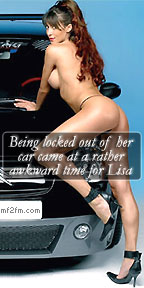 Wireless Waffle last discussed the issue of interference to and from wireless car keys and other similar devices back in 2013, but the topic has cropped up here almost since time immemorial. The original articles discussed the fact that the frequency band used for these devices (around 433.925 MHz) was shared with radio amateurs and that not only were the radio amateurs suffering from interference but that there were cases of car users getting stuck either unable to lock or unlock their cars due to nearby amateur radio transmissions.
Wireless Waffle last discussed the issue of interference to and from wireless car keys and other similar devices back in 2013, but the topic has cropped up here almost since time immemorial. The original articles discussed the fact that the frequency band used for these devices (around 433.925 MHz) was shared with radio amateurs and that not only were the radio amateurs suffering from interference but that there were cases of car users getting stuck either unable to lock or unlock their cars due to nearby amateur radio transmissions.But it seems that the situation has changed and that criminals have cottoned on to the fact that it's possible to jam the transmissions between cars and their keys to their benefit. The BBC reports that thieves in a car park in Berkshire had been 'using car key jammers' and also provides useful advice on the impact and implications of car key jammers.
Now far be it for Wireless Waffle to condone such activities, but it is so brain-achingly simple, and mind-bogglingly cheap, to jam these signals, that it's a surprise that it has taken criminals so long to figure out how to do it.
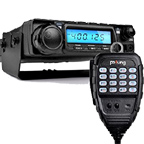 Transmissions from car key fobs normally use either amplitude modulation or fairly crude frequency modulation and the transmitters have a power level of no more than 10 milliWatts. The receivers in the vehicles are manufactured to a price point of around 50 pence and are woefully inadequate at protecting against interference. Thus, a strong enough signal on the same frequency as the car key transmitter (or indeed on a neighbouring one) will overwhealm the low power transmission from the keys. A 40 Watt transmitter (4000 times stronger than the signal from the keys) operating in the same band can be purchased on-line for little more than GBP100.
Transmissions from car key fobs normally use either amplitude modulation or fairly crude frequency modulation and the transmitters have a power level of no more than 10 milliWatts. The receivers in the vehicles are manufactured to a price point of around 50 pence and are woefully inadequate at protecting against interference. Thus, a strong enough signal on the same frequency as the car key transmitter (or indeed on a neighbouring one) will overwhealm the low power transmission from the keys. A 40 Watt transmitter (4000 times stronger than the signal from the keys) operating in the same band can be purchased on-line for little more than GBP100. Such a transmitter would be a brute force way to stop the receiver in the car from being able to hear the signal from the key. This would stop the key from being able to lock the car, meaning that an unsuspecting driver could get out of the car and casually press the button on their key and walk away without listening for the corresponding 'clunk' of the car locking, not realising that the car has not locked. This would clearly leave the car unlocked and easy pickings for a thief.
In principal it would be easy to go one stage further. With a simple receiver it would be possible to record the transmission from the key, and using a low power transmitter, it would be feasible to re-create the signal. In this case, it would be possible for a criminal to unlock a car after it had been safely locked by the driver. Don't say we didn't warn you.
 This is not just possible for car keys, but for any devices which operate in a similar manner. The 433 MHz band used for these devices is replete with a variety of signals from wireless devices such as garage doors, parking barriers and devices for which an attack would be less significant such as weather stations and doorbells. The chart below (known as a waterfall chart) shows, from top to bottom, around 2 minutes of time, and from left to right, the middle portion of the 433 MHz band. A wide range of different transmissions are shown as bars or dots and it is clear there's plenty afoot here despite the transmission area of the devices being very small and thus the limited number of devices in range of the receiver used to perform this scan.
This is not just possible for car keys, but for any devices which operate in a similar manner. The 433 MHz band used for these devices is replete with a variety of signals from wireless devices such as garage doors, parking barriers and devices for which an attack would be less significant such as weather stations and doorbells. The chart below (known as a waterfall chart) shows, from top to bottom, around 2 minutes of time, and from left to right, the middle portion of the 433 MHz band. A wide range of different transmissions are shown as bars or dots and it is clear there's plenty afoot here despite the transmission area of the devices being very small and thus the limited number of devices in range of the receiver used to perform this scan. 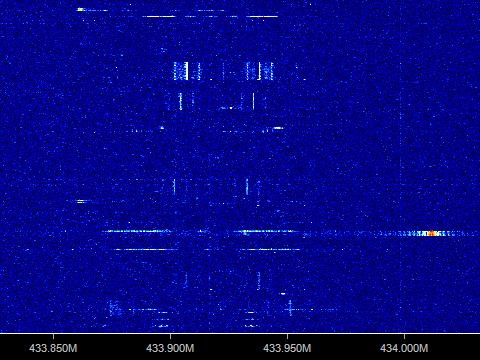
As the number and variety of wireless devices increases, in particular as we progress to the world of the 'Internet of Things' in which there will be sensors and actuators everywhere, it is clear that the security of wireless connections needs beefing up. If you are concerned about your car being 'hacked' by criminals, the best way is to disable the convenience of the wireless key locks and return to the old-fashioned technique of putting the key for your car into the door. Sadly, some modern cars don't actually have this feature any more!
3 comments
( 967 views )
| permalink
| 



 ( 2.9 / 9289 )
( 2.9 / 9289 )




 ( 2.9 / 9289 )
( 2.9 / 9289 )
Thursday 22 January, 2015, 10:48 - Amateur Radio, Broadcasting, Licensed, Radio Randomness, Spectrum Management
Posted by Administrator
Radio amateurs with designs on operating from the planet Mars are appealing against a decision by the Consultative Committee for Space Data Systems (CCSDS) to allocate the 70 cm amateur band (430 - 440 MHz +/-) for communications between satellites in orbit around the red planet and the numerous rovers that criss-cross its surface. Posted by Administrator
In a statement, released by the Mars United People for Planetary and Earth Transmissions (MUPPETs), tea-drinking general secretary Arthur Dent said,
MUPPETs have been planning a DX-pedition to Mars for some time. To discover that our officially allocated radio frequencies are already in use is just not fair. It constrains our ability to talk about radio stuff to each other and means other radio amateurs around the solar-system will be denied extra points in the forthcoming 'talking about radio stuff with other radio nuts' contest.
Responding to the accusations, Prostetnic Vogon Jeltz of the CCSDS commented,
The 70cm frequency band has been used for communications on and off Mars since the Viking lander first set foot on the planet back in 1976. The MUPPETs have had plenty of time to comment. The plans for frequency use on Mars have been available at the local planning office on Alpha Century for fifty of your Earth years, so they've had plenty of time to lodge any formal complaints and it's far too late to start making a fuss about it now. I'm sorry but if they can't be bothered to take an interest in local affairs that's their own regard.
Appallingly obvious references to the Hitch-Hikers Guide to the Galaxy aside, it may surprise many people to learn that there is, indeed, a frequency plan for Mars. And that there are already 5 communication satellites in orbit around the planet! For communication from the rovers on the surface to the orbiting satellites, frequencies in the range 390 to 405 MHz are used. For the link down from the orbiters to the rovers, the frequency range 435 - 450 MHz is used, which falls inside the amateur radio 70cm band.
The choice of the particular frequencies in use (on Mars) is designed to try and stop anyone deliberately causing interference from the Earth, whilst retaining ease of use on Mars (i.e. the ability to use omni-directional antennas). The various satellites orbiting Mars typically get no nearer than around 400 km from the surface and communication with rovers typically takes place when the satellites make their closest pass. The shortest distance between the Earth and Mars is typically around 60 million km. The table below shows the path-loss at 415 MHz of these distances.
| Route | Distance | Path Loss |
|---|---|---|
| Satellite to Mars surface | 400 km | 137 dB |
| Earth to Mars | 60,000,000 km | 240 dB |
So the difference in path loss is just over 100 dB. For a transmitter to cause interference from the Earth to communication on Mars, it would therefore have to have a radiated transmitter power 100 dB higher than the signals passing between the rovers and the satellites.
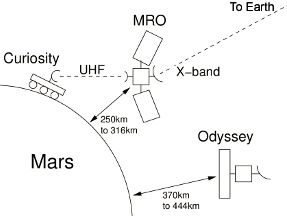 A very good description of the communications with Mars is provided by Steven Gordon (from whom the diagram on the left is shamelessly plagiarised). The transmitter power used on Mars is 5 Watts (7 dBW), so in order to cause interference from Earth, a transmitter power of around 107 dBW, or 50,000,000,000 Watts (a.k.a. 50 GigaWatts) would be required. Would it be possible to generate such a signal?
A very good description of the communications with Mars is provided by Steven Gordon (from whom the diagram on the left is shamelessly plagiarised). The transmitter power used on Mars is 5 Watts (7 dBW), so in order to cause interference from Earth, a transmitter power of around 107 dBW, or 50,000,000,000 Watts (a.k.a. 50 GigaWatts) would be required. Would it be possible to generate such a signal?Firstly, it ought to be possible to generate at least 100,000 Watts (100 kiloWatts or 50 dBW) of power at the necessary frequencies as television transmitters for the UHF band that reach this level are available. So what is then required is an antenna with a gain of 57 dB. This requires a dish with a diameter of around 150 metres. The largest dish antenna in the world is the radio telescope at Arecibo, Puerto Rico, which is 305 metres in diameter.
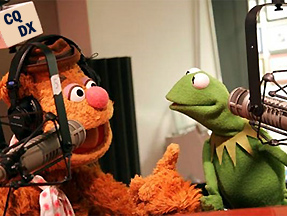 If a high powered television transmitter was therefore connected up to the Arecibo radio telescope antenna, it ought to be more than possible to jam the transmissions between the Mars rovers and the orbiting satellites during periods where the Earth and Mars were closely aligned. Of course this kind of power level is way beyond the normal licensing conditions of a typical radio amateur and the right conditions would occur roughly every 2 to 3 years when the Earth and Mars come closer together. Nonetheless, commenting on this finding, Arthur Dent of the MUPPETs jeered,
If a high powered television transmitter was therefore connected up to the Arecibo radio telescope antenna, it ought to be more than possible to jam the transmissions between the Mars rovers and the orbiting satellites during periods where the Earth and Mars were closely aligned. Of course this kind of power level is way beyond the normal licensing conditions of a typical radio amateur and the right conditions would occur roughly every 2 to 3 years when the Earth and Mars come closer together. Nonetheless, commenting on this finding, Arthur Dent of the MUPPETs jeered,Safe from interference, eh? Who looks silly now then Jeltz!
Back in the early days of citizens band (CB) radio in the UK, when the 40 available channels were busy and bustling, some enterprising operators found that by changing the voltages on the pins of some of the integrated circuits inside their CB radios (the PLL), it was possible to make them operate on channels immediately below the normal 40. These channels were only used by those 'in the know' and were illegal to use (then again when did legality ever bother CB operators?) They became known as the 'moonlight' channels referring no-doubt to their somewhat illicit status and the fact that they tended to be busiest late at night.
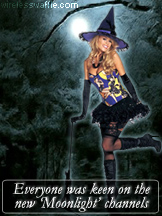 Move forward over 30 years and as of today (31 October 2014), radio amateurs in the UK have access to an additional piece of VHF spectrum from 146 to 147 MHz. Access to this extension to the 2 metre band is only through a notice of variation (NoV) which can be applied for by any full licensee on the RSGB web-site. The new spectrum will initially be available for just 12 months though Ofcom may automatically extend this if they see fit and is on a non-interference basis meaning that radio hams must not cause interference to any legitimate users (e.g. in neighbouring countries) and must accept any interference that those users cause.
Move forward over 30 years and as of today (31 October 2014), radio amateurs in the UK have access to an additional piece of VHF spectrum from 146 to 147 MHz. Access to this extension to the 2 metre band is only through a notice of variation (NoV) which can be applied for by any full licensee on the RSGB web-site. The new spectrum will initially be available for just 12 months though Ofcom may automatically extend this if they see fit and is on a non-interference basis meaning that radio hams must not cause interference to any legitimate users (e.g. in neighbouring countries) and must accept any interference that those users cause.
There are other limitations notably that the maximum transmitter power is 25 Watts, antenna height must not exceed 20 metres and in Scotland (and within 40 km of Scotland) the upper band edge is 146.9375 MHz.
Given the date of the release of this new piece spectrum to radio hams and its uncanny similarity to the original CB band extension (being immediately adjacent to the normal allocation) Wireless Waffle suggests that these new channels be also named the moonlight channels. To celebrate the release of the new VHF moonlight channels, we have compiled a list of one hundred horrible Halloween hits to dampen the spirits at any party.
Anyone for a natter on the newly designated moonlight calling channel of 146.666 MHz tonight?
 Move forward over 30 years and as of today (31 October 2014), radio amateurs in the UK have access to an additional piece of VHF spectrum from 146 to 147 MHz. Access to this extension to the 2 metre band is only through a notice of variation (NoV) which can be applied for by any full licensee on the RSGB web-site. The new spectrum will initially be available for just 12 months though Ofcom may automatically extend this if they see fit and is on a non-interference basis meaning that radio hams must not cause interference to any legitimate users (e.g. in neighbouring countries) and must accept any interference that those users cause.
Move forward over 30 years and as of today (31 October 2014), radio amateurs in the UK have access to an additional piece of VHF spectrum from 146 to 147 MHz. Access to this extension to the 2 metre band is only through a notice of variation (NoV) which can be applied for by any full licensee on the RSGB web-site. The new spectrum will initially be available for just 12 months though Ofcom may automatically extend this if they see fit and is on a non-interference basis meaning that radio hams must not cause interference to any legitimate users (e.g. in neighbouring countries) and must accept any interference that those users cause.There are other limitations notably that the maximum transmitter power is 25 Watts, antenna height must not exceed 20 metres and in Scotland (and within 40 km of Scotland) the upper band edge is 146.9375 MHz.
Given the date of the release of this new piece spectrum to radio hams and its uncanny similarity to the original CB band extension (being immediately adjacent to the normal allocation) Wireless Waffle suggests that these new channels be also named the moonlight channels. To celebrate the release of the new VHF moonlight channels, we have compiled a list of one hundred horrible Halloween hits to dampen the spirits at any party.
Anyone for a natter on the newly designated moonlight calling channel of 146.666 MHz tonight?
Wednesday 12 June, 2013, 11:54 - Amateur Radio
Posted by Administrator
Posted by Administrator
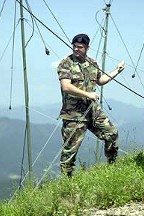 Ofcom have just opened a consultation on the use of 2310 to 2450 and 3400 to 3475 MHz spectrum band by radio amateurs. To cut a long story relatively short, the Ministry of Defence who are the current occupants and owners of these bands, have decided to release parts of them for new uses, most likely to be LTE mobile broadband networks. The MoD are releasing the spectrum from:
Ofcom have just opened a consultation on the use of 2310 to 2450 and 3400 to 3475 MHz spectrum band by radio amateurs. To cut a long story relatively short, the Ministry of Defence who are the current occupants and owners of these bands, have decided to release parts of them for new uses, most likely to be LTE mobile broadband networks. The MoD are releasing the spectrum from:- 2350 – 2390 MHz; and
- 3410 – 3600 MHz.
 This would leave UK radio amateurs with a still reasonably healthy allocation at 2.3 GHz comprising 2310 – 2350 and 2390 – 2450 MHz, noting that the frequencies above 2400 MHz are shared with WiFi, Bluetooth and other licence exempt devices. At 3.4 GHz, the situation is much worse as the current allocation of 75 MHz, would be reduced to just 10 MHz from 3400 – 3410 MHz.
This would leave UK radio amateurs with a still reasonably healthy allocation at 2.3 GHz comprising 2310 – 2350 and 2390 – 2450 MHz, noting that the frequencies above 2400 MHz are shared with WiFi, Bluetooth and other licence exempt devices. At 3.4 GHz, the situation is much worse as the current allocation of 75 MHz, would be reduced to just 10 MHz from 3400 – 3410 MHz.The Ofcom consultation document claims that there are only around 200 or so amateurs who are active in these bands and any economist will tell you that upsetting 200 people for the potential benefit of 60 million, no matter how important those 200 people are, is a no-brainer.
But the consultation is not really about the continued use of the bands which are being handed over to commercial users, it’s more about whether radio amateurs should also be allowed to continue using the other parts of the band. The logic seems to go:
- Once the released chunks of spectrum are given over to new users, any existing use (e.g. MoD, government and programme makers) which was previously in that band, will be concentrated in the remaining pieces of spectrum.
- Whilst, at present, radio amateurs share nicely with existing users, once everyone is forced into less spectrum the potential for interference is commensurately greater.
- Further, as radio amateurs can use high power transmitters, they may also cause interference to the commercial users in the adjacent spectrum.
- As such, it would be easier all round, if the use of the whole of the 2.3 GHz and 3.4 GHz bands, and not just the released bits, were denied to radio amateurs.
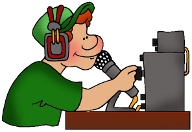 Graciously, Ofcom is not proposing such a draconian measure, but is instead suggesting that radio amateurs be given continued access to the remaining portions of the 2.3 and 3.4 GHz bands but with a reduced notice period of 3 months. The plan would be that if users experience interference from amateurs, Ofcom would terminate amateur use in a 3 month timeframe (instead of the more usual 1 year cut off period). This seems like an eminently reasonable and pragmatic proposal.
Graciously, Ofcom is not proposing such a draconian measure, but is instead suggesting that radio amateurs be given continued access to the remaining portions of the 2.3 and 3.4 GHz bands but with a reduced notice period of 3 months. The plan would be that if users experience interference from amateurs, Ofcom would terminate amateur use in a 3 month timeframe (instead of the more usual 1 year cut off period). This seems like an eminently reasonable and pragmatic proposal.Activities such as this, where users are forced to give way to others is commonplace in the radio spectrum and has been termed ‘re-farming’ as it is akin to a farmer changing the use of his land. Not long ago, Ofcom undertook a similar activity with radiomicrophone users, forcing them out of channel 69 and into channel 38 in the UHF television band to make way for LTE services at 800 MHz. The key difference here, though, is that Ofcom recognised that there was a cost associated with thousands of radiomicrophone users having to buy new equipment, and set up a scheme to fund the replacement of the equipment. The funds were paid for from the dues generated by the sale of the spectrum.
Moving out of the 2.3 and 3.4 GHz amateur bands will incur costs to many radio amateurs, not least those who operate television repeaters within the affected sections. It seems only fair, therefore, that Ofcom (or the MoD) should support radio amateurs by funding the necessary modifications to this equipment, and making the issue of new licences and frequencies as quick and easy as possible. Given how few users there are, this should not be a costly exercise, compared to the sums that will no doubt be raised when the spectrum is sold to commercial market players.

